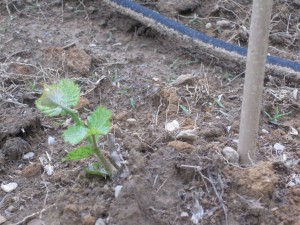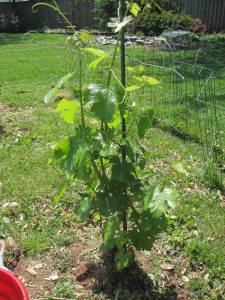Tag: fruiting wire
The Great Experiment — Transplanting Cab Franc
Another busy weekend in the vineyard. We transplanted four Cab Franc vines from Fairfax, researched and ordered a deer fence, and installed the bottom, or fruiting wire on our trellises in Afton. And, of course, we spent some time admiring the fruit of our labors from the previous few weeks – 150 new vines buried under mounds of dirt. The reds, which

Three weeks after planting, the Viognier, pictured here, and the Petit Manseng, are emerging from the mounds of dirt that protected them from the spring frosts.
we planted two weekends ago, were still hidden away, but the whites we planted a week earlier – the Petit Manseng and the Viognier – were poking through the hills, and we were just thrilled to see them pushing through the earth! I have to say, they emerged from the mounds at just the right time, avoiding the frost that killed off our two prize Mammolo Toscano vines the previous weekend. Frost is an issue that we’ve been giving a lot of thought to after our experience this winter, and it influenced our decision on where to locate the fruiting wire. More on that in a future post.
For today, I’ll simply focus on our grand experiment, the transplanting of four of our Cab Franc vines from Fairfax to the Afton vineyard. We had planted a total of seven Cab Francs in Fairfax to get a bit of hands on experience close to home. I suppose at the back of my mind I thought I might eventually make a little wine from those vines, but mostly I

The Fairfax vines looked magnificent this Spring -- if a bit unruly. They need to be pruned, but that, I decided, would wait until they reached their new home.
wanted the experience of being able to go out in the evening after work to care for them and learn from that effort. We planted another five of the same clone and rootstock in Afton to see how the same vines would do in a different environment.
The Fairfax vines grew fast and they looked just beautiful. Clearly, the soil in Fairfax is rich, lending itself to high vigor growth. That’s good and bad, but probably mostly bad. It’s great to see the vines shoot up quickly, but ideally, we’d like them to struggle a bit so that the energy of the plant goes toward the grapes, not the vine itself. Left to its own, the vine will grow as high as it can find support – up a tree, for example, pushing toward the sunlight – but spectacular as that vine might be, Continue Reading–>



Recent Comments